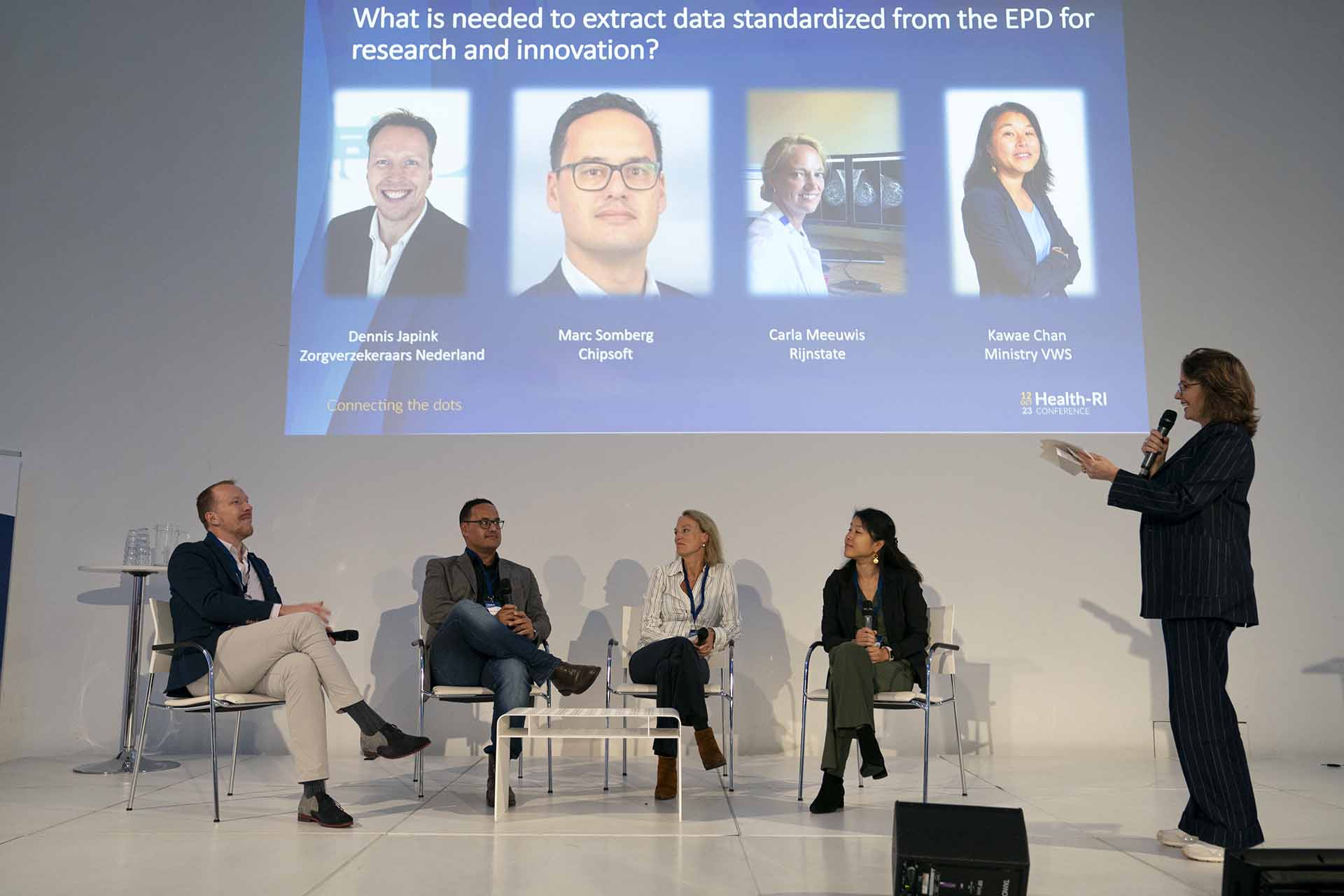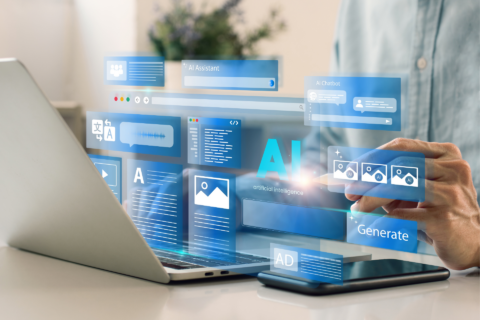No integrated health data exchange and reuse infrastructure without connectivity. That was the theme of the well-attended, recent Health-RI annual conference. During the day, it became clear once again that the intended infrastructure is technically quite well established. But not all stakeholders take it for granted to commit to it without reservation.
To cope with the growing demand for healthcare and the associated cost explosion, the Netherlands must use data more intelligently, effectively and decisively. Where data is now often trapped in digital silos and closed systems, it must flow freely.
Only then can data become of practical value to citizens and medical professionals as well as researchers and businesses. To Health-RI the clean task to build a health data infrastructure that enables the sharing of data. The government has allocated nearly seventy million euros to the foundation for this purpose.
Dotted line
Health-RI seizes the annual conference to share progress with the field. Information needs and involvement are high, as evidenced by the more than six hundred participants ("Next year we'll have to find a bigger hall") who trekked to Jaarbeurs.
'Connecting the Dots' was the title of this year's conference. A problem sketch and a mission in one, CSO Gerrit Meijer of Health-RI made clear. "The blueprint of the data infrastructure now consists of dots, but of course these must become clear lines. Moreover, in the field of digital care, there are many dot solutions. We need to connect these as well and easily as Denmark and Finland do."
Data catalog
About that technical wrap-up, Health-RI in Utrecht had good news to share through technical lead Niels Bolding: "We are celebrating being in the do mode."
By way of illustration, Bolding pointed to the National Health Data Catalog which currently already contains two hundred datasets, provided with a global description and reference to the administrator. The catalog should eventually make all forms of health data findable including an automated request function. Through an open online consultation, Health-RI plans to further refine the concept in mid-December.
Eighteen obstacles
The technical aspects are only one side of the story. "When we talk about connecting the dots, it's also about connecting with each other," Meijer reminded the audience. "You can't do it without connecting with each other."
This is precisely where the shoe sometimes wrings. It has to do with context, Meijer explained. "If you look at it from on high, everyone says about a data infrastructure: do it! But at the detail level, it's still so awkwardly arranged. We previously made a list of the 18 most important obstacles. As a society, we have never had the discussion about the reuse of health data. What are we actually allowed to do? And if it is legally regulated, we also have to implement it technically and organizationally."
Direction versus autonomy
The problem is also at the relationship level. Here and there around the country there are initiatives that more or less resemble a data infrastructure. Health-RI tries to coax the parties involved into a conversation, but it is not always easy. "Everyone asks for direction, but no one wants to lose autonomy," said director Leone Flikweert. "We have to step over our own shadow."
Data as a revenue model
Given the 18 obstacles to a data infrastructure that Health-RI previously identified, that won't be so easy. During the plenary discussions, several podium guests retreated to statements of their own. Sharing data with companies? Not a good idea, said Marcel Heldoorn of the Patient Federation. "I am afraid that my health data will be monetized without me seeing anything in return, while companies have profit margins of 50 to 60 percent."
"With some companies you get along excellently, but there are also companies that are just making money," judged researcher Hanneke van Laarhoven of Amsterdam UMC. "If companies are making money from our data, they should at least invest in the data infrastructure. And if they generate their own data, give us that too!"
"You might as well ask yourself whether it is smart to share all your financial data with a bank that will then give advice on it," Heldoorn said. "With sensitive data, it's all about trust, safeguards and preconditions."
Privacy
Could the use of an encrypted BSN as a linking key be such a safeguard? Marc Smits of Privacy First expressed skepticism. "Medical data are difficult to anonymize. They are so specific that you can easily get back to the individual patient. Third parties should therefore not have access to large, undefined data files."
Instead, Wieteke Wouters of Holland BIO argued that traceability is needed to inform new treatments. "Thanks to technological innovation, we understand better and better why someone is healthy or sick. This allows you to carry out personalized treatments. In practice, these turn out to be very difficult to prove. So you need access to large databases."
EHR as a data source
Whether the Electronic Patient Record (EHR) can serve as a data source is questionable. "It is simply very difficult to extract data from the EPD," said program manager Marijn Kroes of AI company Pacmed from the audience. According to critics, it is mainly the EHR vendors that make this difficult. Linking for the purpose of exchange is possible, but then hospitals have to pull the purse strings. Links are not standard in the EHR and must be built with it.
Registration chaos
Marc Somberg of market leader ChipSoft rebounded nicely. "To get data out of something, you first have to put it into something. That has to be easier. Currently, hospitals still use 27 different ways to register blood pressure. I believe this means there are now 4,700 links. At different hospitals I hear different things instead of: we have to do a better job there."
Open APIs
That ChipSoft used building links as a revenue model over the years, Somberg implicitly disputed. "Linking and exchanging data should not be a commercial revenue model," he told the room.
Whether this means that tomorrow Dutch hospitals can get started with generic interfaces, also referred to as open APIs, remains to be seen. As far as the Ministry of VWS is concerned, the discussion is shifting from data exchange to data availability. "We need to start separating data and functionality," said policy officer Kawae Chan. By capturing data independent of the specific application, in the view of VWS, it can be more easily reused for different purposes.
Data is everywhere
It may be cold comfort to know that many of the problems that hamper the Netherlands in developing an open data infrastructure also exist elsewhere. In the United Kingdom, for example, where Health-RI's counterpart has been active for some time and also has a much larger budget at its disposal.
"We are in the midst of the fourth industrial revolution," said Health Data Research UK (DRUK) director Andrew Morris, who served as key note in Utrecht. "By 2030 we are estimated to have 30 billion networked devices. Data is really everywhere. Only it's not accessible. Access to data is what slows us down."
New governance
Still, according to Morris, data-driven care is not higher math. "It's about people, not technology. So we try to pay extra attention to the control and governance of data. People are rightly concerned that their data is being looted by companies. We need new models for public-private partnerships that explicitly focus on revenue sharing."
Funders choose FAIR
Morris' plea gave extra relief to the special step that Dutch funders of research and innovation in health care made public during "Connecting the Dots. In a joint statement, ZonMw, KWF Kankerbestrijding and Health~Holland promised to apply the same principles to the assessment of applications from now on.
Not only does this eliminate the need for applicants to jump through "various hoops," but the funders involved expect the data for each study to be FAIR from now on. That is, findable, accessible, interoperable and reusable.
Findable, accessible, interoperable and reusable. It's quite a mouthful for what is in fact nothing more than an explicit enshrinement of the public interest in data-driven healthcare research.












